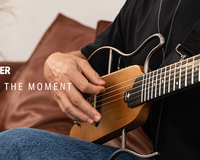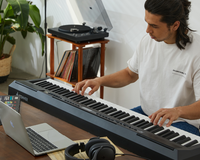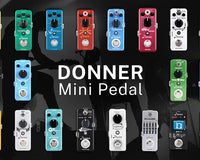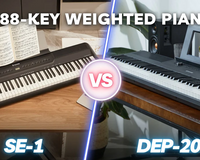Just like the electric bass and guitar, the drums have their own electronic version: the electronic drum set. Do you want the flexibility to change your sounds, and access to hundreds of different sounds for each of your drums and cymbals? Do you want the sounds of much more expensive and professional drum kits at a much lower cost? Do you dream of being able to fold up and tuck away your drum kit to get back valuable space in your home? Getting an electronic drum kit from Donner will make all of these dreams come true.
In this guide, we will go through most of the critical information that beginners may or should consider when purchasing an electronic drum kit. You will also learn some details about each part of the drum kit and how they work. Information about future trends of acoustic drums and electronic drums, and their pros and cons will also be provided. As always, if you still have questions after reading this guide, feel free to contact us.
Table of Contents
Introduction to the Electronic Drum Kit
Influenced by guitar, many people may think that the relationship between acoustic drums and electronic drums is similar to that acoustic and electric guitars. The truth is more complicated. The principle of the electric guitar is that the string induces a current in a magnetic field. Then the pickup picks up the analog signal and then sends it to the amplifier. No digital signal occurs while playing. Electronic drums are different. After the trigger embedded in the drum head is engaged, an electric signal is generated by the sensor, which is converted into a digital MIDI signal. The audio source then plays the prerecorded sound sample files associated with that drum and the velocity (strength) of the hit carried by the MIDI signal, so that we can hear the sound of the drum. This is why a guitar is "electric" and drums are "electronic". In short, in an electric guitar, you hear the direct sounds of the strings, while on the electronic drum set your strikes on the drum trigger the processor to play prerecorded sounds.

Donner DED-100 Electronic Drum Set
Why Choose an Electronic Drum Kit/ Pros and Cons?
Electronic drum kits were originally created as a substitute for the much louder acoustic drum kits to allow drummers to practice more quietly. After several iterations of the product, artists have adopted electronic drums as a great way of playing live electronic music. In recent years, the technology of electronic drum kits has only improved, with concerted effort from designers and developers. Dynamics have been increased. The range of the electric drums in response to the dynamics of the player is getting higher and the quality of sampled sounds is getting better. The versatility of the electronic drums has also been improved: more classical, original drum timbres can be simulated, and the ability to tune timbre, pitch, balance, sound field and other dimensions has been improved. These features can drastically improve the quality and playability of a drum kit.

Donner DED-200 Electronic Drum Kit
The advantages of the electronic drum kit are its controllable sound, and its highly customizable sample libraries. It also avoids many disadvantages of acoustic drums. Acoustic drums are incredibly loud, disturbing to the people you live with, and can potentially damage your hearing if proper protection isn’t worn. Also, the sound they make is the sound they make, and only minor adjustments can be made through tuning the drum heads. In addition to the costs of various kinds of cymbals and the drums themselves, you still have to pay a considerable amount of money for sound absorbing insulation in your recording space. This cost can be prohibitive for beginners. What's more, recording on acoustic drums is very inconvenient. If you really want to get serious about acoustic drum recording, various costs start to add up. These include sound treatment, drum heads, microphones, recording interfaces, and others that can add up to thousands of dollars. Moreover, electronic drum kits with mesh heads bring a softer and more realistic feeling than those with a hard surface. Basically, you can view the electronic drum set as a drum-shaped MIDI input device that combines with a hardware audio source to generate audio signals. For this reason, manufacturers make sure to work just as hard on the PC interface to ensure low latency and a variety of awesome sounds. Finally, the portability of electronic drums also provides you with extra convenience if you ever consider going out for gigs.

Although electronic drums have many advantages, they also have a couple of serious disadvantages that will never make them a perfect substitution for acoustic drums. For one thing, samples are samples. They will never have a more expressive quality than acoustic drums. The dynamic range of an electronic drum will never surpass that of a real drum. Another flaw is that electronic drum sets limit your dynamic capabilities because sample sets only have so many layers of sampled sounds and MIDI can only carry 128 different velocity values. If you are looking for the precise dynamic nuance and feeling of acoustic drums, and you have the sufficient budget and space, an acoustic drum kit is more suitable for you.
What to Look for in an Electronic Drum Kit
The Module
The drum module is the most significant part of a drum kit. It is like the CPU of a PC. The sounds coming out of the drums are processed in here. It also stores all the prerecorded sounds, special effects, and even sounds of other instruments here. In different electronic drum kits, the quality of a module can determines the quality of the kit. The sounds available may differ in quantity and type. The Module also allows you to adjust parameters like volume output. You can also record your playing and generate audio files that you can edit later on a computer. Also, the module contains several preset drum kits specially set up for different music styles. You can either use the preset kits or you can customize your own kits.

Firstly, when choosing an electronic kit, you should consider the quality and variety of the sounds that the module provides. A fake-sounding kit gradually wears down your enthusiasm for playing the drums . If you need one, there are fantastic modules that allow you to customize your sounds. If you are a beginner that currently has little knowledge of drums, mindlessly going for a top module is not always the best choice. The highest level modules are incredibly complex and feature a high learning curve. Failing to make sounds that you like because of this complexity can really take the fun out of playing. The next thing you should pay attention to is the audio feedback of the module and its latency. High quality modules feature great acoustic drum sounds and low latency, so it feels more like you’re playing the real thing. Good modules are also able to handle a wide variety of dynamics incredibly well. Most modules include adjustable sensitivity so you can adjust the kit to your playing style. You can also change the frequency of every individual part to make sure your sounds blend in the mix perfectly.
As mentioned earlier, if you want to record your playing, a module with a USB port makes it a lot easier for you to do so. Modules with USB outputs ports enable you to send your audio into interfaces so you can record directly and let your bandmates hear your playing. Also, an important part of learning to play the drums is playing along with other songs, so a module with an audio input is ideal. Make sure you are getting the module with the input and output ports that you need.
The Triggers
Triggers and mesh heads are the two main parts of the drum. As mentioned, triggers detect strikes on the mesh head, then transfer signals to the module, which then plays the corresponding prerecorded sounds. You may want to have triggers with multiple sensors because a sensor only triggers a single kind of sound. With more sensors installed in different parts of the drum, you can get several sounds by playing those different parts of the drum.
Cymbal
In a normal electronic drum kit, the shape of the cymbals is identical to acoustic ones. However, in some more affordable models, you may see some cymbals that are only sections of acoustic ones. Cymbals offered by high-end models even move like acoustics cymbals. You will be able to swing and choke your cymbals when needed in your playing. When you look for a drum set, it is always better to choose one that offers multiple triggers in the cymbals. More triggers in the cymbals, more playability, and a more realistic experience playing. It is possible, with the right kit, to translate all of your acoustic drum techniques to an electronic kit.
Besides normal cymbals, hi-hats are also an important consideration. Triggers, in particular, are vitally important. Being able to accurately track and model the opening and closing of the hi-hats is vital. Triggers that more accurately, and smoothly model this transition are ideal in this situation. Bad triggers leads to abrupt changes in sound, which can throw you off and make for worse recordings.

Mesh Heads
Mesh heads serve as the drumhead of electronic drum kits. They play an important role in affecting the physical feel of your playing. When e-drums were first invented, people played on drumheads mad of formica tabletop, which was exceptionally tiring for drummers doing gigs. The hardness of this kind of top fatigues your hands, wrists and arms. In time, the tabletop was replaced by a rubber pad and then a mesh head. Rubber pads have a similar feel and bounce to the muting practice pads you see on the acoustic ones. Usually, rubber pads are all pretty similar because they all have consistent hardness and bounce, making them cheaper to manufacture. As a result, they are more often seen on affordable kits. Among all the drum tops, mesh heads that incorporate a woven surface provide a bouncier feel and desirable dynamics. In contrast to the consistent rubber pads, mesh heads are adjustable in their tension, which makes them nicer to use and more expensive.

Expansion
Drum Amplification and Monitoring
If you plan to do gigs in a band in the future, it is important to have a drum amplification and monitoring system. To be heard by your bandmates , you have to have your module plugged into an amplifier. If you don’t plug in a headset, you will need a speaker so you can hear yourself playing. Placing the speaker too far away from you may cause some disorientation because it might feel like the sounds are not coming from your drums.
If the main use of your drums is to practice at home, a good quality headset is recommended. A headset will give you the most direct sound of your playing and it avoids disorientation. It also reduces noise that may bother your neighbors or housemates. Having a headset with better low frequency response is also recommended so that you can hear the full thump of your kick drum and low tom.
Electric-Acoustic Kits
If you want to combine the worlds of electronic drumming and acoustic drumming, you can add electronic triggers to an acoustic kit (drums and cymbals) to give you both options.
Extra Drums and Cymbals
As you progress in your playing and achieve a higher level of performance, expanding your drum kits is inevitable. Exactly like with acoustic kits, electronic kits allow you to expand your setup and customize as you want. Do pay attention to whether the module of your drum kit has enough input jacks for you to plug in your expansions.

Donner DED-200 Expansion Cymbal Kit
The Donner DED-200 expansion cymbal is injection molded from high quality materials and can transmit vibration to the sensor. The customized sensor has high sensitivity, dynamic response, and anti-interference characteristics. The steel support frame is stable and safer, and the adjustment is more convenient. We pay attention to every detail of construction so that you can focus entirely on the music. Before playing, you will need to adjust the cymbal to your preferred position.
Accessories
If you plan to expand your drum kit, there are some accessories for you to consider. Even if expansion is not your thing, some extra accessories can help you play more conveniently and comfortably.
Drums Amplifier
Although you can hear your playing by plugging in a headset, an amplifier and cables may also be needed if you plan to do a live performance where you can’t plug into the sound system directly.

Donner DA-35 Drum Amplifier
The Donner DA-35 35 watt electronic drum amplifier is an innovative 35-watt amplifier. It has two signal input ports. It supports line input and microphone input. It is an ideal amplifier for use with computers, mobile phones or any other audio playback device, including your drum module! As you can see, in addition to AUX in, the DA-35 also supports Bluetooth wireless input, and the control knob on the amplifier panel can also be used to control wireless devices. The 2-inch tweeter and 8-inch woofer can play back sound with more detail and dynamics. Simply plug an MP3 player/ mobile phone/ laptop/ tablet into the auxiliary input or connect wirelessly through bluetooth to the DA-35, and you can hear the tracks and play along like you were a member of the band. Use the 1/8-inch headphone output jack for private practice. The enclosed design provides you with a heavy bass response, the edges are surrounded by hard materials to protect the amplifier from damage, and the rubber pad makes it safe and stable.
Bench
Since a lot of drum kits do not come with a drum throne (drum bench) in the package, you might need to pick one up extra. Make sure it is one that suits a variety of playing heights and is comfortable for you to sit on.

Donner Drum Throne
When you’re concentrating on your drum performance, a high quality stool can make all the difference. The Donner drum throne can give you everything you want. The high-density sponge of the bench seat keeps it from deforming and can support up to 250 pounds of weight. You can also make the top seat rotate 360 degrees by slightly loosening the knob under the seat bag. The drum stool height can be shrunk and folded by adjusting the bottom knob, which makes it easy to transport.

Donner Adjustable Drum Throne
The Donner adjustable drum throne is ergonomically designed and specially suited for drummers. The Donner drum throne consists of a comfortable sitting pad and sturdy fixed steel legs. This drum throne can be useful to a variety of musicians. No matter if you're a keyboard player, a guitarist, or even a brass player, it is nice to have a comfortable stool where you can sit and just enjoy playing your musical instrument.
More Information
This is the end of this electronic drums buying guide. We hope you now have a clearer idea of what you are looking for. After reading this guide, if you’re still not sure about your choice, feel free to contact us.












































